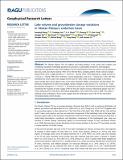Files in this item
Lake volume and groundwater storage variations in Tibetan Plateau's endorheic basin
Item metadata
| dc.contributor.author | Zhang, Guoqing | |
| dc.contributor.author | Yao, Tandong | |
| dc.contributor.author | Shum, C. K. | |
| dc.contributor.author | Yi, Shuang | |
| dc.contributor.author | Yang, Kun | |
| dc.contributor.author | Xie, Hongjie | |
| dc.contributor.author | Feng, Wei | |
| dc.contributor.author | Bolch, Tobias | |
| dc.contributor.author | Wang, Lei | |
| dc.contributor.author | Behrangi, Ali | |
| dc.contributor.author | Zhang, Hongbo | |
| dc.contributor.author | Wang, Weicai | |
| dc.contributor.author | Xiang, Yang | |
| dc.contributor.author | Yu, Jinyuan | |
| dc.date.accessioned | 2019-03-13T13:30:09Z | |
| dc.date.available | 2019-03-13T13:30:09Z | |
| dc.date.issued | 2017-06-16 | |
| dc.identifier | 258136418 | |
| dc.identifier | 6c1ff93a-1db4-498f-9e48-560c42828c9a | |
| dc.identifier | 85020118011 | |
| dc.identifier.citation | Zhang , G , Yao , T , Shum , C K , Yi , S , Yang , K , Xie , H , Feng , W , Bolch , T , Wang , L , Behrangi , A , Zhang , H , Wang , W , Xiang , Y & Yu , J 2017 , ' Lake volume and groundwater storage variations in Tibetan Plateau's endorheic basin ' , Geophysical Research Letters , vol. 44 , no. 11 , pp. 5550-5560 . https://doi.org/10.1002/2017GL073773 | en |
| dc.identifier.issn | 0094-8276 | |
| dc.identifier.other | ORCID: /0000-0002-8201-5059/work/55379135 | |
| dc.identifier.uri | https://hdl.handle.net/10023/17273 | |
| dc.description.abstract | The Tibetan Plateau (TP), the highest and largest plateau in the world, with complex and competing cryospheric-hydrologic-geodynamic processes, is particularly sensitive to anthropogenic warming. The quantitative water mass budget in the TP is poorly known. Here we examine annual changes in lake area, level, and volume during 1970s–2015. We find that a complex pattern of lake volume changes during 1970s–2015: a slight decrease of −2.78 Gt yr −1 during 1970s–1995, followed by a rapid increase of 12.53 Gt yr −1 during 1996–2010, and then a recent deceleration (1.46 Gt yr −1 ) during 2011–2015. We then estimated the recent water mass budget for the Inner TP, 2003–2009, including changes in terrestrial water storage, lake volume, glacier mass, snow water equivalent (SWE), soil moisture, and permafrost. The dominant components of water mass budget, namely, changes in lake volume (7.72 ± 0.63 Gt yr −1 ) and groundwater storage (5.01 ± 1.59 Gt yr −1 ), increased at similar rates. We find that increased net precipitation contributes the majority of water supply (74%) for the lake volume increase, followed by glacier mass loss (13%), and ground ice melt due to permafrost degradation (12%). Other term such as SWE (1%) makes a relatively small contribution. These results suggest that the hydrologic cycle in the TP has intensified remarkably during recent decades. | |
| dc.format.extent | 11 | |
| dc.format.extent | 1047797 | |
| dc.language.iso | eng | |
| dc.relation.ispartof | Geophysical Research Letters | en |
| dc.subject | groundwater storage | en |
| dc.subject | lake volume | en |
| dc.subject | mass balance | en |
| dc.subject | Tibetan Plateau | en |
| dc.subject | Geophysics | en |
| dc.subject | Earth and Planetary Sciences(all) | en |
| dc.subject | 3rd-DAS | en |
| dc.title | Lake volume and groundwater storage variations in Tibetan Plateau's endorheic basin | en |
| dc.type | Journal article | en |
| dc.contributor.institution | University of St Andrews. School of Geography & Sustainable Development | en |
| dc.contributor.institution | University of St Andrews. Bell-Edwards Geographic Data Institute | en |
| dc.identifier.doi | 10.1002/2017GL073773 | |
| dc.description.status | Peer reviewed | en |
| dc.date.embargoedUntil | 2018-11-02 |
This item appears in the following Collection(s)
Items in the St Andrews Research Repository are protected by copyright, with all rights reserved, unless otherwise indicated.

